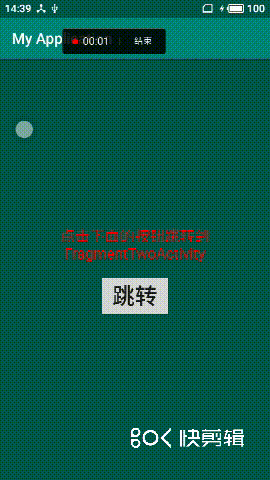为了更好的理解以下内容,我们需要简单了解一下Fragment的动态注册方法
Android——Fragment的静态注册和动态注册
为了实现从Fragment跳转到其他Activity,下面需要创建以下文件:

第一步:简单编写布局文件fragment_activity.xml和抽象类TemplateFragmentActivity.java代码如下:
fragment_activity.xml
<?xml version="1.0" encoding="utf-8"?> <FrameLayout xmlns:android="http://schemas.android.com/apk/res/android" android:id="@+id/temp_fragment_activity" android:layout_width="match_parent" android:layout_height="match_parent"> </FrameLayout>
fragment_activity.xml布局主要用于承载各fragment布局,例如fragment_one.xml和fragment_two.xml。
TemplateFragmentActivity.java
package com.example.myapplication;
import android.os.Bundle;
import androidx.annotation.Nullable;
import androidx.appcompat.app.AppCompatActivity;
import androidx.fragment.app.Fragment;
import androidx.fragment.app.FragmentManager;
import androidx.fragment.app.FragmentTransaction;
public abstract class TemplateFragmentActivity extends AppCompatActivity
{
private FragmentManager fm;
private FragmentTransaction ts;
private Fragment fragment;
//抽象方法,用于创建Fragment实例
protected abstract Fragment createFragment();
@Override
protected void onCreate(@Nullable Bundle savedInstanceState) {
super.onCreate(savedInstanceState);
setContentView(R.layout.fragment_activity);
fm = getSupportFragmentManager();
ts = fm.beginTransaction();
if (fragment == null){
fragment = createFragment();
ts.add(R.id.temp_fragment_activity,fragment);
ts.commit();
}
}
}
第二步:分别使类FragmentOneActivity和FragmentTwoActivity继承类TemplateFragmentActivity并实现抽象方法createFragment()
FragmentOneActivity.java
package com.example.myapplication;
import androidx.fragment.app.Fragment;
public class FragmentOneActivity extends TemplateFragmentActivity {
@Override
protected Fragment createFragment() {
return new FragmentOne();
}
}
FragmentTwoActivity.java与FragmentOneActivity.java类似,不在重复。
第三步:分别编写fragment_one.xml和fragment_two.xml布局文件并通过编写FragmentOne.java和FragmentTwo.java绑定对应的布局文件,并实现其具体功能。
fragment_one.xml
<?xml version="1.0" encoding="utf-8"?> <LinearLayout xmlns:android="http://schemas.android.com/apk/res/android" android:layout_width="match_parent" android:layout_height="match_parent" android:gravity="center" android:background="@color/colorPrimaryDark" android:orientation="vertical"> <TextView android:layout_width="wrap_content" android:layout_height="wrap_content" android:gravity="center" android:text="点击下面的按钮跳转到FragmentTwoActivity" android:textSize="20sp" android:textAllCaps="false" android:textColor="#F70505"> </TextView> <Button android:id="@+id/btn_fm_one" android:layout_width="wrap_content" android:layout_height="wrap_content" android:text="跳转" android:textSize="30dp" android:layout_marginTop="20dp"> </Button> </LinearLayout>
fragment_two.xml与fragment_one.xml类似,不在重复。
FragmentOne.java
package com.example.myapplication;
import android.content.Intent;
import android.os.Bundle;
import android.view.LayoutInflater;
import android.view.View;
import android.view.ViewGroup;
import android.widget.Button;
import androidx.annotation.NonNull;
import androidx.annotation.Nullable;
import androidx.fragment.app.Fragment;
public class FragmentOne extends Fragment {
private Button mBtnFragmentOne;
@Nullable
@Override
public View onCreateView(@NonNull LayoutInflater inflater,
@Nullable ViewGroup container,
@Nullable Bundle savedInstanceState) {
View view = inflater.inflate(R.layout.fragment_one,container,false);
mBtnFragmentOne = view.findViewById(R.id.btn_fm_one);
mBtnFragmentOne.setOnClickListener(new View.OnClickListener() {
@Override
public void onClick(View v) {
Intent intent = new Intent(getActivity(),FragmentTwoActivity.class);
startActivity(intent);
}
});
return view;
}
}
Fragment跳转到Activity与Activity跳转到Activity方法类似,如下:
Intent intent = new Intent(getActivity(),FragmentTwoActivity.class); startActivity(intent);
FragmentTwo.java与FragmentOne .java类似,不在重复。
演示·:

总结
以上所述是小编给大家介绍的Android从Fragment跳转到其他Activity的简单实例,希望对大家有所帮助!
